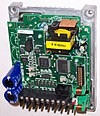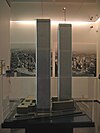User:SpaceyWP/sandbox/Selected article
Selected article 1
User:SpaceyWP/sandbox/Selected article/1
The Rolls-Royce Merlin is a British liquid-cooled, 27-litre (1,650 cu in) capacity, V-12 piston aero engine, designed and built by Rolls-Royce Limited. Initially known as the PV-12, Rolls-Royce named the engine the Merlin following the company convention of naming its piston aero engines after birds of prey.
The PV-12 first ran in 1933, and a series of rapidly applied developments brought about by wartime needs improved the engine's performance markedly. The first operational aircraft to enter service using the Merlin were the Fairey Battle, Hawker Hurricane and Supermarine Spitfire. More Merlins were made for the four-engined Avro Lancaster heavy bomber than for any other aircraft; however, the engine is most closely associated with the Spitfire and powered its maiden flight in 1936.
Read more...
Selected article 2
User:SpaceyWP/sandbox/Selected article/2
A space elevator is a proposed structure designed to transport material from a celestial body's surface into space. Many variants have been suggested, all of which involve travelling along a fixed structure instead of using rocket powered space launch. The concept most often refers to a structure that reaches from the surface of the Earth on or near the Equator to geostationary orbit (GSO) and a counter-mass beyond.
The concept of a space elevator dates back to 1895 when Konstantin Tsiolkovsky[1] proposed a free-standing "Tsiolkovsky" tower reaching from the surface of Earth to geostationary orbit. Most recent discussions focus on tensile structures (specifically, tethers) reaching from geostationary orbit to the ground. This structure would be held in tension between Earth and the counterweight in space like a guitar string held taut. Space elevators have also sometimes been referred to as beanstalks, space bridges, space lifts, space ladders, skyhooks, orbital towers, or orbital elevators.
Selected article 3
User:SpaceyWP/sandbox/Selected article/3
The construction of the World Trade Center was conceived as an urban renewal project, spearheaded by David Rockefeller, to help revitalize Lower Manhattan. The project was developed by the Port Authority of New York and New Jersey, which hired architect Minoru Yamasaki who came up with the specific idea for twin towers.
The towers were designed as framed tube structures, which provided tenants with open floor plans, uninterrupted by columns or walls. The elevator system, which made use of sky lobbies and a system of express and local elevators, allowed substantial floor space to be freed up for use as office space by making the structural core smaller. The design and construction of the World Trade Center twin towers involved many other innovative techniques...
Selected article 4
User:SpaceyWP/sandbox/Selected article/4

Electrical engineering is a field of engineering that generally deals with the study and application of electricity,electronics and electromagnetism. The field first became an identifiable occupation in the late nineteenth century after commercialization of the electric telegraph and electrical power supply. It now covers a range of subtopics including power, electronics, control systems, signal processing and telecommunications.
Electrical engineering may include electronic engineering. Where a distinction is made, usually outside of the United States, electrical engineering is considered to deal with the problems associated with large-scale electrical systems such as power transmission and motor control, whereas electronic engineering deals with the study of small-scale electronic systems including computers and integrated circuits. Alternatively, electrical engineers are usually concerned with using electricity to transmit energy, while electronic engineers are concerned with using electricity to transmit information. More recently, the distinction has become blurred by the growth of power electronics. Read more..



